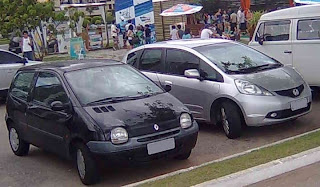Starting in the 60's, going thru the 70's and 80's, artesanal double-cab conversions were a popular mod in Brazilian-made trucks, due to the unavailability of factory-equipped versions. If early ones were pretty simple, just a crew-cab work truck like that old blue Chevrolet C-10 fitted with a 250cu.in. Stovebolt Six and a collumn-shift 3-speed manual transmission, they started to become trendy after '76 due to automobile import restrictions, becoming an option to customers in the market for luxury cars, which then had a low availability. Larger rear cab extensions started to become prevalent, offering enought room for comfort features such as a sofa-bed and home appliances such as TV and fridge, to make longer trips more pleasurable.
Some models, such as the Chevrolet C-20 (which ethanol-powered versions were locally-named A-20 and Diesel ones D-20, and export ones B-10), started to have crew-cab versions in the 80's, but weren't so luxurious as the artesanal conversions. A curious feature to note is than most converted double-cab trucks had only 2 doors, once a trend in Brazilian market for budget reasons and concerns about child safety, while a crew-cab from the factory had 4 doors.
The 90's came with a market reopening, and Japanese crew-cab trucks started to hit the streets. With its smaller, more fuel-efficient engines, better maneuverability in tight spaces and improved driving comfort in opposition to full-size trucks which often still didn't even have power steering, started to take over the local truck market. The segment had nearly to reinvent it to survive. many conversion shops closed, others started to sell accessories to the Japanese newcomers, while a few still remain on this market.
Some models such as the Chevrolet S10, introduced to the Brazilian market only in '95 and since then the best-selling truck, had a potential market for crew-cab versions, which OEM extended-cab couldn't fully meet. Until '97, meanwhile a factory crew-cab wasn't available, the gap had to be filled by the aftermarket conversions. Even after that, some customers still enjoy the artesanal double-cabs since they provided more room to the back seat, making it more comfortable for family use and improving the comfort in longer trips.
The double-cab conversions market is still not extinct, in spite of the much lower volume. In addition to more traditional body-on-frame trucks such as the Ford F-250, it also started to draw more attention to unibody front-wheel drive coupé-utilities such as the Ford Courier which are very popular in Brazil in spite of the unavailability of a double-cab/crew-cab for most of those.
It may look dumb for some customers, but for many others it's important to have an open deck which makes easier to fit some larger bulks in a counterpoint to a regular sedan...
The only coupé-utility with an available double-cab is the Fiat Strada, in a response to few customers who were retrofitting rear bench seats into factory-offered extended-cab versions to carry 2 more passengers in spite of its tight space.
In spite of all the factors which led to its decline, the artesanal double-cab conversions are not fully extinct, mainly due to the ability to provide more personallized solutions than an OEM would, exactly due to its lower market volume...























































